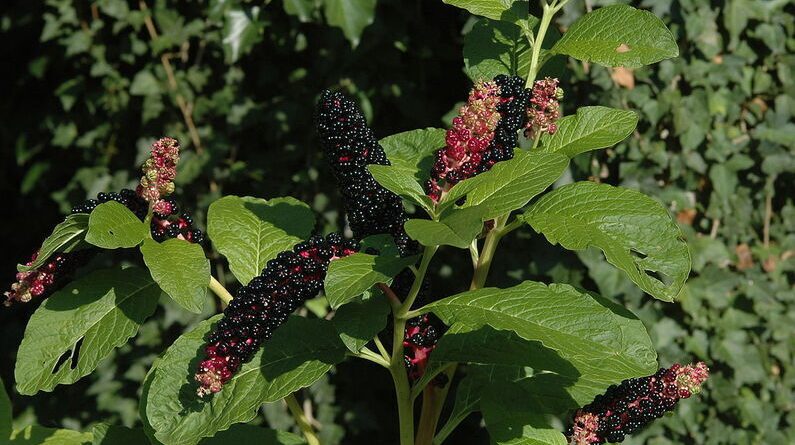Pokeweed Optimizes Your Immune Response
To American aboriginals, immigrant-natives and folks raised in the rural south, pokeweed plant has been consumed as both culinary dish and disease deterrent medicine.
Pokeweed (Phytolacca Americana) is found in North America, the West Indies, parts of Europe and Asia. In North America, particularly, pokeweed grows along roads, fences, streams, and abundantly in fields typically populated with other wild plants such as milk thistle. Pokeweed remains an abundant, resilient, uncultivated plant despite invasive encroachments by non-native humans, alien flora and fauna. But it is Pokeweed’s natural antiviral, lymphatic, and anti-inflammatory properties which make this plant of interest to both holistic and conventional medicine researchers. The berries, stems, immature leaves and roots of pokeweed are used medicinally in a variety of formats, such as tinctures or decoctions. Pokeweed berry tincture when prepared and stored correctly becomes a potent anti-cancer, anti-inflammatory, anti-viral, medicine as do young pokeweed leaf decoction when boiled sufficiently (at least 2 water changes). Both formats, tincture and decoction, stimulate positive immune response when taken under strategically controlled circumstances. Poke leaves prepared correctly can also act as a cathartic (stimulates bowel evacuation).
Before indicating optimum circumstances, an explanation of immune response is necessary. Medical dictionary online defines immune response as, “the reaction to an interaction with substances interpreted by the body as
not self, the result being humoral (body fluids like blood or lymph) and cellular immunity. In terms of what is optimum protection, resistance and repair, both cellular mediated and humoral immune responses should be the objective when dealing with anything from rheumatism to viral attacks. Phytochemicals in the berry tinctures and leaf decoctions are used by T-cells receptors in order to produce interleukins, or autocrine receptor hormones.
Herb and botanical merchants typically sell dried pokeweed root for external usage only, but rarely will you find poke berries (sometimes containing poke root) in tincture form being sold because poke berries are considered highly toxic. Fact is, ripe poke berries are highly potent chemically and the least toxic part of poke plant. The root of the plant is the most toxic. Five to 8 drops, 3 times a day of poke berry tincture taken orally is enough to vanquish or inactivate various viruses, such as SARS and corona group of viruses. Topically, pokeweed tincture full-strength or diluted in salve or water repairs or relieves the following conditions: itching caused by poison ivy, psoriasis outbreaks, rheumatism, and arthritic joint inflammation.
Ways to Prepare Pokeweed Plant
Should you decide to harvest and prepare pokeweed medicinal remedies yourself, use common sense logic in each step. For example, never collect pokeweed along roadways, or public parks. When preparing to make poke root decoction keep in mind that it is the mature plant growth that you want not a young poke plant. When pokeweed is young, about 6-10 inches in height, harvest stems and leaves for use in pokeweed infusions and decoctions. Use the boil-change water-boil again method. Boil poke leaves, stems or roots in water for 21 minutes. Change the water and boil again for 21 minutes. On the third go, bring heat to low and allow to simmer for 15 minutes. Remove pot or kettle from heat and let the plant matter sweat for 15 minutes before straining into a jar. This cooking down process removes or neutralizes saponins and phytotoxins like glycoside. The final liquid can be ingested by tablespoon or using a medicine dropper. Take 2 tablespoons 3 times a day for 3 days or 5-10 drops, 3 times a day for 3 days. Fully mature pokeweed grows anywhere from 5-10 feet or 1.5-3 meters. Snip 1 or 2 shoots from the roots of a flowering pokeweed plant. Replace the plant back into the ground to allow it to continue growing. Once maturing pokeweed flowers turn into fruit, around mid to late summer, then you can harvest the pea-sized dark berries. It is extremely important to research how to prepare pokeweed tincture or have an experienced apothecary/herbalist concoct tincture for you. If you buy commercial or prepare your own pokeweed berry or root tincture, check that the alcohol used was 100 proof vodka which is 50:50 (water to alcohol). It’s also a good idea to freeze berries so they fall off the vine easier as well as release more phytochemicals once immersed in alcohol for 6 to 8 weeks. Some people due to preexisting conditions experience skin reactions from simply touching pokeweed berries or leaves. Pregnant women, nursing mothers, and young children should not handle nor ingest pokeweed in any format, tincture, decoction, or medicinal elixir. As with any other plant medicines, it is wise not to ingest pokeweed along with other medications for safety sake without educating yourself and seeking professional advice from a competent, experienced holistic health provider. Always seek professional advice before self-administering any plant-based medicine.
You Know the Deal…
What’s the law of Pharoh’s House regarding use of any medicinal regimen? Always compliment your reparative regimens by altering or switching up your meals with naturally healthy, unprocessed foods, cleansing fasts, and periodic detoxifying. Poke root tincture and pookweed decoctions impact your immunity grid best when:
- meals are void of acidic, processed, or fried foods
- you eat foods that produce nitric oxide in cells (red cabbage, aged garlic, beet juice, grapefruit, leafy greens)
- you consume tincture or decoction as a preventive measure not when ailing from depressed immunity
If you have certain allergies, or strong aversions to pokeweed plant, use an alternative, such as elderberry or apple skins and apple seeds or dark grapes and their seeds.
Author bio: Pharoh is a Health-wellness writer-researcher
and Counselor-Educator at PharohsHouse
Additional Resources:
